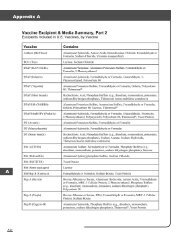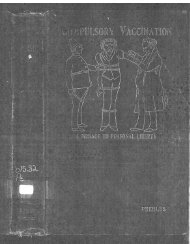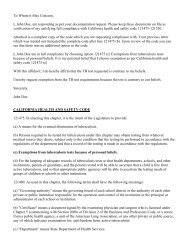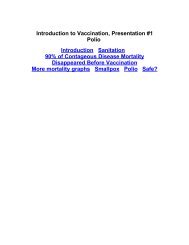Vitamin K
Vitamin K
Vitamin K
Create successful ePaper yourself
Turn your PDF publications into a flip-book with our unique Google optimized e-Paper software.
Page 1<br />
By Karin Rothville DipCBEd.<br />
For the last 40 or 50 years, it has become a<br />
generally accepted fact that vitamin K<br />
prevents haemorrhagic disease of the<br />
newborn, and routine administration of<br />
vitamin K to all newborns has been<br />
recommended. 3, 6, 21, 34, 72 This<br />
recommendation has been questioned<br />
because results released in 1990 from a<br />
study by Golding and colleagues 26 in the UK<br />
showed a two to three times increased risk<br />
of childhood cancers, especially leukaemia,<br />
in children given prophylactic drugs (usually<br />
intramuscular vitamin K) in their first week.<br />
A further study in 1992 seemed to confirm<br />
this risk. 25<br />
There was widespread anxiety among<br />
parents when these findings were<br />
published. Parents were, understandably,<br />
reluctant to have their baby receive a<br />
substance that could predispose it to cancer<br />
in childhood, and many health workers were<br />
also reluctant to give, without prescription,<br />
a possibly cancer-causing substance to<br />
prevent a disease that few, if any, of them<br />
had ever seen. These concerns are not the<br />
first time that vitamin K safety has been<br />
questioned. So, what is the controversy<br />
about vitamin K? And does it predispose<br />
babies to childhood cancer?<br />
WHAT IS VITAMIN K AND WHAT DOES IT DO?<br />
<strong>Vitamin</strong> K is a fat-soluble substance which<br />
triggers off the blood-clotting process.<br />
Blood clotting is a complex process and can<br />
be described as a sequence of three stages,<br />
requiring up to 12 different coagulation<br />
factors. 72 The liver needs vitamin K to<br />
synthesise four of these factors. <strong>Vitamin</strong> K<br />
is also needed for the formation of other<br />
proteins found in plasma, bone and<br />
33, 58<br />
kidney.<br />
As with other fat-soluble vitamins, a normal<br />
flow of bile and pancreatic juice is<br />
necessary for digestion, and the presence of<br />
dietary fat, especially short-chain fatty<br />
acids, enhances absorption. Absorbed<br />
vitamin K is transported via the lymph into<br />
the systemic circulation. 58<br />
Normally, a significant portion (up to 55%)<br />
of absorbed vitamin K is excreted so the<br />
amount in the body is small and its turnover<br />
is rapid (about 30 hours). 58 <strong>Vitamin</strong> K is<br />
stored and re-utilised in the body for 3-4<br />
weeks. 33<br />
<strong>Vitamin</strong> K is found in many foods. Leafy,<br />
dark green and deep yellow vegetables are<br />
the best sources. 58 Alfalfa 18 is a good<br />
source; and milk and dairy products, eggs,<br />
cereals, fruits and other vegetables also<br />
provide small but significant amounts. As<br />
the liver of adults contains about equal<br />
amounts of plant and animal forms of<br />
<strong>Vitamin</strong> K, it is assumed that vitamin K is<br />
produced in the intestinal tract by bacterial<br />
flora. One of the reasons given for the low<br />
levels of vitamin K in newborn babies is<br />
because their gut has not yet been<br />
colonised by the required bacteria.<br />
Recommended daily dietary intakes of<br />
vitamin K 58<br />
Category Age Amount (µg)<br />
Infants 0 – 1 10<br />
Children 1 – 3 15<br />
4 – 6 20<br />
7 – 10 25<br />
Adolescents 11 – 14 30<br />
15 – 18 35<br />
Adult Male 19 – 45<br />
70+<br />
Adult Female 19 – 35<br />
70+<br />
Pregnancy + 10<br />
Lactating + 20<br />
The dietary requirements for vitamin K in<br />
infants and children are estimates and are<br />
based on weight and growth rates as
compared to adults. Many unsupplemented<br />
breasfed infants do not show clinical signs<br />
of vitamin K deficiency on intakes of less<br />
than 3 µg daily and the mean requirement<br />
for infants is estimated to be 5 µg daily<br />
based on weight. The higher amount of 10µ<br />
g is recommended for prevention of<br />
Haemorrhagic Disease of the Newborn. 58<br />
WHAT IS HAEMORRHAGIC DISEASE OF THE<br />
NEWBORN?<br />
Haemorrhagic Disease of the Newborn<br />
(HDN) is a bleeding disorder associated with<br />
low levels of vitamin K in newborn babies.<br />
It was first defined in 1894 by Townsend 69<br />
as spontaneous external or internal<br />
Page 2<br />
bleeding occurring in newborn infants not<br />
due to trauma, accident or inherited<br />
bleeding disorders such as haemophilia.<br />
Previously, there were no generally agreed<br />
upon criteria to determine causes of<br />
haemorrhaging, so any diagnosis was based<br />
solely on the opinion of the attendant<br />
medical personnel.<br />
Infants are born with low levels of vitamin<br />
K 23 compared to adults and this is termed<br />
‘vitamin K deficiency’. Up to 50% of babies<br />
develop this ‘vitamin K deficiency’, but<br />
bleeding occurs in only a fraction of these<br />
cases. 37 In most it starts after birth,<br />
becomes<br />
progressively more severe over 48-60<br />
hours, then spontaneously corrects itself by<br />
72-120 hours. 9<br />
HDN has always been rare – in Britain where<br />
maternity units practised a selective policy<br />
of vitamin K administration, the incidence<br />
was no more than 1 in 20,000 in the years<br />
1972-80. Estimates for late onset HDN are<br />
4-8 per 100,000. 45 Incidence also seems to<br />
vary from country to country.<br />
HDN is divided into three categories:<br />
1. Early onset HDN occurs in the first 24<br />
hours. It is very rare and mainly<br />
associated with mothers who have taken<br />
anticonvulsant, antibiotic,<br />
antituberculous or anticoagulant drugs<br />
during pregnancy.<br />
2. Classic HDN occurs in the first week<br />
after birth. It is manifested by the<br />
oozing of blood from the intestines, the<br />
nose, the cord site and broken skin sites.<br />
Bruising at sites where there has been<br />
no trauma can also appear.<br />
3. Late onset HDN occurs after the first<br />
week, with a peak incidence between<br />
the second and sixth weeks, and about<br />
half the cases present with intracranial<br />
bleeding (bleeding into the brain).<br />
WHAT ARE THE RISK FACTORS FOR HDN?<br />
There has been some debate over the years<br />
as to whether or not HDN is actually caused<br />
by vitamin K deficiency. Certainly, giving<br />
vitamin K does arrest bleeding in the<br />
majority of cases, but this does not mean<br />
that vitamin K deficiency causes HDN. One<br />
may as well say that an antibiotic deficiency<br />
causes bacterial infection. There is also no<br />
consensus as to what level of vitamin K in<br />
plasma protects against HDN. Some<br />
researchers have found no evidence of<br />
vitamin K deficiency in babies in their<br />
studies 43, 49 and other factors have also<br />
52, 73, 74<br />
been suggested.<br />
Most, if no all, of the reported cases of late<br />
onset HDN have presented with problems<br />
which affect the baby’s ability to absorb or<br />
utilise vitamin K. 45, 56 These include:<br />
hepatitis, cystic fibrosis, chronic diarrhoea,<br />
bile duct atresia, alpha-1-antitrypsin<br />
deficiency, coeliac disease of insufficient<br />
plasma transport capacity. Subclinical<br />
cytomegalovirus has also been implicated.<br />
<strong>Vitamin</strong> K-responsive bleeding syndrome<br />
has been well documented after antibiotic<br />
therapy, especially with cyclosporins. 33<br />
There are other factors which place the<br />
newborn at higher risk. These include preterm<br />
birth (as the liver is very immature),<br />
low birth weight, instrumental or traumatic<br />
delivery, bruised or bleeding in the first few<br />
days after birth, requiring surgery or<br />
circumcision, taking inadequate feeds and<br />
breastfeeding. 33<br />
BREASTFEEDING – WHY IS IT A RISK?<br />
Several authors have noted the higher<br />
incidence of HDN in solely breastfed<br />
babies. 9, 30 The incidence has been quoted<br />
as 1 in 1200. 30 Studies comparing<br />
breastmilk with formula and cow’s milk<br />
have shown that breastmilk is lower in<br />
vitamin K. 22, 28, 32 Breastmilk substitutes are<br />
heavily supplemented with vitamin K,<br />
however, it is possible that, like iron,<br />
vitamin K is biologically more available to<br />
the baby from breastmilk, and so such high<br />
levels are not necessary.
Measured levels of vitamin K in breastmilk<br />
seemed to vary depending on the type of<br />
measurement used; however, they all come<br />
out lower than cow’s milk. Fournier 22 and<br />
Greer 28 found levels of around 8-9µg/l,<br />
which would mean that if a baby was taking<br />
in about 500ml per day, it would be getting<br />
the recommended 3-5µg daily.<br />
<strong>Vitamin</strong> K content and availability are<br />
greater in the hind milk because of its<br />
higher fat content and vitamin K levels are<br />
also higher in colostrum. 32 As an extra plus,<br />
breastmilk contains thromboplastin, one of<br />
the factors in blood clotting. 18<br />
<strong>Vitamin</strong> K levels in the breastmilk rise<br />
markedly in response to the mother eating<br />
vitamin K rich foods or taking vitamin K<br />
supplements. 29, 54 Nishiguchi found no cases<br />
of low vitamin K levels in breastfed infants<br />
whose mothers had been given<br />
supplements, as opposed to infants who<br />
had only been given 1 or 2 doses of oral<br />
vitamin K. 54<br />
Unrestricted access to the breast in the<br />
early days after birth is important, due to<br />
the higher levels of vitamin K in colostrum.<br />
The importance of early feeding has been<br />
recognised since the 1940’s. Babies who<br />
have been fed within their first 24 hours<br />
have significantly better coagulation times<br />
than babies not fed until after 24 hours. 24<br />
It is essential that, to receive the full<br />
complement of vitamin K in breastmilk, the<br />
baby completely finishes one breast before<br />
being offered the other. Any practice that<br />
involves restricting either the baby’s time at<br />
the breast or the number of feeds will not<br />
allow the baby to receive optimum amounts<br />
Page 3<br />
of vitamin K and will also prolong the time it<br />
takes for the baby’s intestine to be<br />
colonised by friendly, vitamin K<br />
manufacturing bacteria.<br />
THE HISTORY OF VITAMIN K USE TO PREVENT<br />
HDN.<br />
The search for the cause of HDN began in<br />
1913 when Whipple 82 postulated that a lack<br />
of prothrombin activity could be a cause of<br />
HDN. In 1929, Henrik Dam 14 noticed that<br />
chicks fed a fat-free diet suffered<br />
subcutaneous and intramuscular<br />
haemorrhages, which could be prevented if<br />
the chicks were fed seeds, cereals and<br />
green, leafy plants. Dam described the<br />
condition as a vitamin deficiency and<br />
named the deficient vitamin ‘vitamin K’,<br />
from the Danish word ‘koagulation’.<br />
Research in 1937 8 found that prothrombin<br />
times in normal neonates were between 30-<br />
60% adult levels, falling to 15-30% on day<br />
two, and then gradually rising again until<br />
about day 10. This research led to the<br />
continuing belief that these low levels in the<br />
newborn are a deficiency and need to be<br />
corrected.<br />
In 1939, vitamin K 1 was isolated from alfalfa<br />
by Dam, for which he later received the<br />
Nobel Prize, along with Edward Doisy, who<br />
isolated vitamin K 2 . 45 Further research in<br />
1939 by Waddell and Guerry 81 found that<br />
low plasma prothrombin levels could be<br />
elevated by the administration of oral<br />
vitamin K.<br />
Armed with this ‘proof’ that vitamin K<br />
deficiency caused HDN, vitamin K was<br />
synthesised and various trials were<br />
commenced<br />
to ascertain which was the most effective<br />
amount and route to use in prophylaxis.<br />
It is difficult for us to assess these trials<br />
nowadays as they were mostly neither<br />
double blind nor well controlled. The<br />
dosage of vitamin K given, the route of<br />
administration and the time of<br />
administration all varied. In many cases,<br />
the conclusions did not seem to match the<br />
results. 72<br />
Some of the studies assessed the effect on<br />
neonatal vitamin K levels if the mother was<br />
given vitamin K during labour. 72 Results<br />
varied, with the effectiveness of the vitamin<br />
K given depending on how soon the woman<br />
gave birth and the dosage given. More<br />
recent studies have shown increases in cord<br />
blood levels where mothers were<br />
supplemented antenatally with vitamin K. 1,<br />
66<br />
Two showed a significant difference<br />
between the supplemented and<br />
unsupplemented groups and found that the<br />
effect of prenatal vitamin K persisted until<br />
the fifth day after birth. 1<br />
Because of the variations in results from<br />
these early studies, further research<br />
focussed on treating the baby after birth.<br />
One particular study done in 1942 31 was<br />
intended to determine the minimal effective
oral dose of Synkavite (K 3 ), a water-soluble<br />
synthetic form of vitamin K. The results<br />
showed that very small daily doses were<br />
effective and that a dose of 5µg daily would<br />
probably prevent the development of HDN,<br />
except in early onset cases. The study also<br />
found that 1.25mg was effective in lowering<br />
an excessively high prothrombin time to<br />
normal. However, the author admitted that<br />
several workers found prothrombin<br />
deficiencies in babies with no abnormal<br />
bleeding.<br />
By 1950, most maternity units had a policy<br />
of giving infants oral vitamin K (usually<br />
Synkavite) immediately after birth. 70 This<br />
prevented the fall in prothrombin levels that<br />
occurred in the first few days and,<br />
presumably, the risk of excessive bleeding.<br />
This risk was higher in male babies because<br />
of routine circumcision, and, indeed, vitamin<br />
K proved to be of great clinical value in<br />
preventing post-circumcision bleeding. 75<br />
Then, in the mid-1950’s, reports of<br />
increased jaundice and kernicterus (brain<br />
damage caused by high bilirubin levels)<br />
associated with vitamin K prophylaxis<br />
began circulating. Reviews of maternity<br />
units found that some were giving<br />
Synkavite in doses exceeding 50mg. 70 It<br />
was established that high doses of<br />
Synkavite caused haemolysis (destruction<br />
of red blood cells) and high serum bilirubin<br />
levels. 48<br />
Researchers and medical professionals<br />
queried the safety<br />
aspects of vitamin K, and there were many<br />
conflicting reports on the appropriate<br />
dosages. Some researchers queried the<br />
need for vitamin K at all, quoting results<br />
from studies that showed no difference in<br />
prothrombin times or vitamin K plasma<br />
levels between babies that bled and babies<br />
that didn’t. 72<br />
Eventually, a newer preparation,<br />
intramuscular vitamin K1<br />
(phytomenadione), was developed and<br />
approved for use, solely on the grounds that<br />
it appeared to cause less haemolysis.<br />
Phytomenadione (trade names Konakion<br />
(Roche) or Aquamephyton (Merck, Sharpe &<br />
Dohme)) is a synthetic petrochemical<br />
derived from 2-methyl 1,4-naptha-quinone<br />
in a polyethoxylated castor oil base. 18 In<br />
the US, polysorbate-80 is used as a base<br />
instead of polyethoxylated castor oil. 15<br />
In spite there being no long term trials of<br />
these preparations, the American Academy<br />
of Pediatrics recommended that<br />
phytomenadione be administered<br />
prophylactically to all newborn babies. 72<br />
The use of oral vitamin K preparations fell<br />
out of favour in the USA and the ‘safer’<br />
intramuscular route became the route of<br />
choice.<br />
In Britain, after the jaundice scare of<br />
the1950’s, many maternity units began to<br />
practice a selective policy, giving vitamin K<br />
only to babies at risk of haemorrhaging.<br />
McNinch reported in 1980 that less than<br />
half the maternity units in the UK gave<br />
vitamin K to all newborns. 47 Some of these<br />
babies were given oral prophylaxis and<br />
some were given intramuscular prophylaxis.<br />
In Germany, almost all newborn infants who<br />
required medical care and instrumental<br />
deliveries were given intramuscular vitamin<br />
K, and some healthy newborns also<br />
received it. 76 Records have not always been<br />
kept in New Zealand hospitals, so it is<br />
impossible to say whether or not vitamin K<br />
was given routinely and by which route. 17<br />
Although vitamin K use seemed to prevent<br />
most cases of HDN, there was still<br />
controversy. Not everyone believed vitamin<br />
K deficiency was the cause of HDN. In<br />
1977, van Doorm et al 52, 73, 74 suggested<br />
that HDN could be caused by a heparin-like<br />
inhibitor in the newborn and he concluded<br />
that babies given their first feed soon after<br />
birth do not have a vitamin K deficiency.<br />
Other researchers agreed with van Doorn. 49<br />
In 1980, Malia et al 43 could find no evidence<br />
of vitamin K deficiency in babies in their<br />
study and concluded that low levels of<br />
vitamin K dependent clotting factors were<br />
due to the immature liver. The authors of<br />
these studies questioned whether vitamin K<br />
prophylaxis was really necessary for healthy<br />
newborns.<br />
Then, starting in November 1980, there was<br />
a cluster of six cases of HDN in Britain, all<br />
within 17 months. 46 Half of these cases<br />
were classic HDN, the other half were a new<br />
manifestation of HDN – late onset.<br />
LATE ONSET HDN<br />
Late onset HDN was first reported in 1977. 5<br />
It mainly occurs in breastfed infants and<br />
to ¾ of cases have an underlying liver<br />
disorder or malabsorption syndrome, 15
ather than insufficient dietary intake of<br />
vitamin K. This means the liver cannot<br />
adequately synthesise blood clotting factors<br />
or store adequate amounts of vitamin K.<br />
Liver function cannot be easily diagnosed at<br />
birth without a range of invasive tests and<br />
thus there exists an unknown risk of<br />
haemorrhaging.<br />
Many factors contribute to poor liver<br />
function, including hepatitis, cystic fibrosis,<br />
Page 4<br />
antibiotic therapy, biliary atresia, alpha-1-<br />
antitrypsin deficiency, a-betalipoproteinaemia,<br />
coeliac disease, chronic<br />
diarrhoea and exposure to pharmacologic<br />
agents such as anticonvulsants, rifampin,<br />
isoniazid cephalosporins and coumarin<br />
compounds 33 When tested, most of the<br />
reported cases of late onset HDN had<br />
hepatitis, liver malfunction or enzyme<br />
6, 35, 51, 80<br />
deficiencies.<br />
Birkbeck 6 believes there are two processes<br />
at work – low levels of prothrombin and<br />
vitamin K-dependent clotting factors VII, IX<br />
and X at birth, and a further fall in these in<br />
the neonatal period. In his view the initial<br />
low levels are not due to vitamin K<br />
deficiency as levels of 2 other non-vitamin<br />
K-dependent factors, XI and XII are also<br />
often reduced. Thus, the situation at birth<br />
may be simply due to hepatic immaturity.<br />
Birkbeck 6 also reports that HDN is almost<br />
unknown in central Africa and he suggests<br />
an environmental mechanism as the cause.<br />
Associated with this, a discussion paper<br />
from the University of Amsterdam 42 raises<br />
the idea that by-products of our industrial<br />
society such as PCBs, PCDDs and PCDFs are<br />
the cause of late onset HDN. These<br />
chemicals can induce enzymes in the liver<br />
which cause liver damage and prolong<br />
prothrombin time. Although overseas<br />
studies have reported contamination of<br />
breastmilk by these pollutants, a NZ<br />
Department of Health study on breastmilk<br />
reported that levels of these contaminants<br />
were at the lower end of the scale. 7 The<br />
Health Department is currently conducting<br />
another study to see if levels have changed<br />
over the past few years.<br />
There seems to be a seasonal variance, with<br />
most cases of late onset HDN occurring in<br />
the warmer months. 6 It has been suggested<br />
that the mother could have contracted a<br />
viral infection during pregnancy in the<br />
colder months and this has crossed the<br />
placenta. Since viruses have an affinity for<br />
the liver and mucous membranes, they can<br />
affect intestinal absorption and liver<br />
function. 67<br />
Another suggested cause of late onset HDN<br />
includes use of the food antioxidant BHT<br />
(butylated hydroxytoluene), which has<br />
produced vitamin K deficiency. 68 BHT is<br />
present in many processed foods, including<br />
margarine. Our Western diets consist of a<br />
lot of processed food, and to reduce fat<br />
intakes, margarine is recommended rather<br />
than butter. The polyunsaturated fat in<br />
margarine is an inhibitor of vitamin K<br />
absorption. 68 Both of these factors could<br />
have an effect on the amount of vitamin K<br />
available to pass through to the baby. A<br />
high level of vitamin K in the mother’s blood<br />
is necessary to ensure adequate<br />
transplacental transfer of vitamin K. 9, 33 It is<br />
important for the baby to have adequate<br />
stores of vitamin K in its liver at birth to<br />
prevent bleeding until its feeding and gut<br />
flora are established.<br />
Of the six cases of HDN in Britain in 1980-<br />
1982, all were breastfed and none had<br />
received vitamin K at birth. 46 Two of the<br />
cases were in the high-risk group – one was<br />
born by caesarean section and had an<br />
epileptic mother treated with phenytoin,<br />
and the other had an alcoholic mother who<br />
had taken anti-depressants – and obviously<br />
should have received vitamin K at birth.<br />
These cases prompted a call for the reintroduction<br />
of routine prophylaxis. Many<br />
opposed the idea of unnecessarily injecting<br />
40, 47, 55, 79<br />
otherwise healthy babies so studies<br />
were therefore conducted to determine<br />
whether oral vitamin K was as effective as<br />
intramuscular. It was also proposed that<br />
oral vitamin K would be more cost-effective<br />
and thus better suited for use in Third World<br />
countries. 55 Results of these studies varied.<br />
Some showed that oral vitamin K was<br />
effective in preventing classic haemorrhagic<br />
disease but not as effective as<br />
intramuscular vitamin K in preventing late<br />
onset HDN. 47, 55, 78 Others found oral as<br />
effective, especially a 10 year study<br />
conducted on 38,000 infants in Sweden<br />
where no cases of HDN were observed over<br />
that period. 40 Tripp and McNinch reported<br />
no cases in 25,000 babies in their maternity
unit where only those at risk were given<br />
intramuscular prophylaxis and the rest oral<br />
prophylaxis. 70<br />
In spite of these findings that oral vitamin K<br />
prophylaxis was not effective in preventing<br />
late onset HDN, it continued to be used in<br />
British maternity units, especially for low<br />
risk infants.<br />
RISKS OF VITAMIN K PROPHYLAXIS<br />
Konakion ampoules contain phenol,<br />
propylene glycol 38 and polyethoxylated<br />
castor oil as a non-ionic surfactant. Studies<br />
in animals given polyethoxylated castor oil<br />
have shown a severe anaphylactic reaction<br />
associated with histamine release. Strong<br />
circumstantial evidence implicates<br />
polyethoxylated castor oil in similar<br />
reactions in humans. Polyethoxylated<br />
castor oil, when given to patients over a<br />
period of several days, can also produce<br />
abnormal lipoprotein electrophoretic<br />
patterns, alterations in blood viscosity and<br />
erythrocyte aggregation (red blood cell<br />
clumping). Individuals sensitive to this base<br />
are contraindicated from using Konakion.<br />
New Ethicals Compendium also warns that<br />
the use of Konakion can cause jaundice and<br />
kernicterus in infants. 53 Other listed side<br />
effects include flushing, sweating, cyanosis,<br />
a sense of chest constriction, and peripheral<br />
vascular collapse. Local cutaneous and<br />
subcutaneous changes may occur in areas<br />
of repeated intramuscular injections.<br />
This synthetic, injectable vitamin K<br />
formulation was never subjected to a<br />
randomised, controlled trial. In new drugs<br />
that are to be used for prophylaxis, the<br />
usual risk/benefit analysis does not apply,<br />
since the individual is not ill. The ethical<br />
principle of non-maleficence (primum non<br />
nocere – first do no harm) applies and the<br />
trials must thus be larger in order to identify<br />
any previously unrecognised side effects. 65<br />
Since this did not happen, nor was there<br />
any long term follow up, we actually have<br />
little idea of the effects of this drug on<br />
newborn babies.<br />
The risks of injecting vitamin K into a<br />
newborn baby are nerve or muscle damage<br />
as the preparation must be injected deeply<br />
into the muscle, not subcutaneously under<br />
the skin. There is also the documented risk<br />
of injecting the baby with the syntocinon<br />
intended for the mother. 30, 70 As stated in<br />
the product information, 53 infants can suffer<br />
from jaundice or kernicterus (brain damage<br />
from a build-up of bile pigments in the<br />
brain) from Konakion. Infants who have the<br />
enzyme deficiency G6PD (glucose 6<br />
phosphate dehydrogenase) are at particular<br />
risk from vitamin K. 30 The other risk factor<br />
is the possible increased chance of<br />
childhood cancer.<br />
THE LINK BETWEEN CHILDHOOD CANCER AND<br />
INTRAMUSCULAR VITAMIN K<br />
In 1970, a national cohort study of 16,193<br />
infants born in one week in April was begun<br />
in Britain. 26 This study was to test<br />
Page 5<br />
hypotheses about childhood cancers and<br />
their associated factors. Thirty-three of the<br />
children had developed cancer by age 10<br />
and were compared with 99 control<br />
children, matched on maternal age, parity<br />
and social class. One of the unlooked-for<br />
risk factors was the administration of<br />
prophylactic drugssuch as vitamin K in the<br />
first week after birth – a nearly three-fold<br />
risk. This association fitted no prior<br />
hypothesis and the authors recommended<br />
that their finding be tested in another series<br />
of cases.<br />
The authors of the study approached Roche,<br />
the manufacturers of Konakion, for funding<br />
for a further trial to examine the findings<br />
more closely. Roche was not interested<br />
until, a few months later, the media<br />
reported the results of the study and that<br />
vitamin K given to babies might cause<br />
childhood cancer. Roche then decided to<br />
fund a new study. 27<br />
The new study 25 was a case-control study of<br />
195 children with cancer born at either of<br />
two hospitals in Bristol, England, compared<br />
with 588 healthy children also born at these<br />
hospitals. One hospital predominantly gave<br />
vitamin K orally and the other<br />
intramuscularly. The authors found a nearly<br />
two-fold risk of leukaemia in children who<br />
had received intramuscular vitamin K.<br />
These findings were extremely worrying.<br />
Golding calculated that the extra cases of<br />
leukaemia caused by vitamin K injection<br />
could be as many as 980 in the UK alone. 25<br />
These results were supported by reports of<br />
the potential carcinogenicity of vitamin K<br />
from Israels et al, who suggested that low<br />
vitamin K levels in the newborn protect
against the risk of mutations during a<br />
period of rapid cell growth and division. 39<br />
Pizer et al did not find any association<br />
between the route of vitamin K<br />
administration and mutations in cells but<br />
concluded that his study was too small to<br />
show any real effect. 62 Another study<br />
reported no increase in abnormalities in<br />
newborn infants, but, with only 12 infants,<br />
the study was too small to show any real<br />
effect. 10 It is worth noting that after an<br />
intramuscular dose of vitamin K, the baby’s<br />
plasma levels are almost 9000 times the<br />
normal adult levels. 47 It has also been<br />
suggested that the cancer-causing agent<br />
could be a metabolite, N-epoxide, or some<br />
other component of the solution other than<br />
vitamin K itself. 15<br />
Golding’s study was criticised by many.<br />
One of the reasons was that the authors<br />
had to make assumptions for some cases,<br />
as the information on vitamin K<br />
administration was not clearly recorded. In<br />
spite of this, expert epidemiologists<br />
considered that the results were plausible<br />
and so could not be lightly dismissed. 15<br />
Further studies were proposed to answer<br />
the question of cancer and vitamin K.<br />
In 1993, results from three retrospective<br />
studies on vitamin K and childhood cancer<br />
were published. The studies were done in<br />
41, 57, 19<br />
the USA, Denmark and Sweden.<br />
These studies, although large, did not<br />
confirm the association between<br />
intramuscular vitamin K and childhood<br />
cancer. One of the studies not only showed<br />
no association between IM vitamin K and<br />
childhood cancer, it also showed no<br />
association between maternal smoking and<br />
childhood cancer, a finding totally at odds<br />
with the results from many other studies. 19<br />
The other two studies were also not<br />
comparable to the British study. One<br />
because of differences in type of vitamin K<br />
given 41 and the other because of the use of<br />
birth cohorts with differing regimens of<br />
vitamin K usage. 57<br />
Because of the design flaws in these<br />
studies, there was still a need for further<br />
case-control studies. Results from two were<br />
published in 1996. 2, 77 They had carefully<br />
matched controls and more accurate<br />
information on whether vitamin K had been<br />
given or not, and by which route. One of<br />
the studies 2 reported no association<br />
between intramuscular vitamin K and<br />
childhood cancer and the other 77 found a<br />
risk of leukaemia, but only when cases were<br />
compared with local controls (i.e. from the<br />
same hospital) and not with controls<br />
randomly selected from the whole area<br />
under study. This, although suggestive, was<br />
not followed up but dismissed as a chance<br />
finding related to multiple testing.<br />
The suggestion was then put forward that,<br />
as these studies had failed to show a<br />
definite association between intramuscular<br />
vitamin K and childhood cancers, worries<br />
about any potential cancer risk should be<br />
abandoned. 83<br />
At that time, four more studies on vitamin K<br />
and cancer were in progress. 44, 59, 60, 61 The<br />
results from these four studies were<br />
published in 1998. Two of them failed to<br />
confirm any increased risk of childhood<br />
cancers. 44 61 One of the other studies<br />
showed a twofold risk of acute<br />
lymphoblastic leukaemia among 1-6 year<br />
olds, 59 the other showed a significant risk<br />
for all cancers. 60<br />
So, the jury is still out on whether there is<br />
an increased risk of childhood leukaemia<br />
with the intramuscular form of vitamin K.<br />
Some recommend that intramuscular<br />
vitamin K should still be used, as the risk of<br />
leukaemia “seems more hypothetical than<br />
real”. 76 Others believe that public<br />
confidence in IM vitamin K has been<br />
severely shaken and will be difficult to<br />
restore fully. They recommend an oral<br />
regimen similar to that used in the<br />
Netherlands of 25µg daily, given by the<br />
mother. This would avoid the grossly<br />
unphysiological peaks of vitamin K from<br />
both the IM route and the present oral<br />
route. 71<br />
ORAL VITAMIN K VS INTRAMUSCULAR<br />
The two main problems with giving vitamin<br />
K orally are that there is no licensed oral<br />
formulation, meaning that babies receive<br />
the intramuscular form orally, and that<br />
compliance with three oral doses is poor as<br />
many doctors and midwives are reluctant to<br />
give an unlicensed formula. 13 The use of<br />
unlicensed preparations may theoretically<br />
expose professionals to litigation in the<br />
event of prophylactic failure or unforeseen<br />
adverse events. 2<br />
Roche, the manufacturers of Konakion, state<br />
that they do not recommend the
administration of Konakion solution orally. 63<br />
Their reasons are:<br />
- that they have no clinical studies to<br />
support oral use,<br />
- phenol, which has been reported to be<br />
an irritant to newborns mouths, is used<br />
as a preservative,<br />
Page 6<br />
- the variability in the production of bile<br />
salts in newborns may affect absorption,<br />
- that Konakion given orally has a small<br />
association with anaphylactic reactions.<br />
The preparation was also unpleasant to<br />
taste and babies were inclined to spit it<br />
out 82 or to vomit it back up. Only about half<br />
of an orally administered dose is<br />
absorbed. 47 Even so, the plasma<br />
concentrations in babies who were given<br />
oral vitamin K reached 300 times the adult<br />
levels, before dropping off slightly after<br />
about 24 hours. 47<br />
After the publication of Golding’s studies,<br />
further trials were done on oral vitamin K<br />
prophylaxis and whether it gave longer<br />
term protection. In 1992, Cornelissen 11<br />
found plasma vitamin K concentrations<br />
were higher in the group given IM vitamin K<br />
than the oral group, but blood coagulability,<br />
activities of factors VII, X and PIVKA-II<br />
concentrations showed no differences. By 3<br />
months follow-up, vitamin K levels had<br />
dropped in both groups but more in the oral<br />
group. He suggests that neither give long<br />
term protection. One would assume that<br />
babies should be producing their own<br />
vitamin K by 3 months and, if not, what<br />
other mechanism could be hindering this<br />
process.<br />
Von Kries et al 78 studied repeated oral<br />
vitamin K prophylaxis in Germany, with 3x 1<br />
mg doses and found that it was not as<br />
effective as a 1mg intramuscular dose at<br />
birth. Another study by Cornelissen et al 12<br />
reported on the effectiveness of differing<br />
regimens of oral vitamin K in four different<br />
countries – the Netherlands, Germany,<br />
Switzerland and Australia (two differing<br />
regimes). In the Netherlands, babies are<br />
given 25 µg daily oral vitamin K for 3<br />
months with I mg given at birth either orally<br />
for healthy newborns or intramuscularly for<br />
unwell babies. In Germany, the regime is 3<br />
x 1 mg oral doses as was also the case in<br />
Australia from 1993 to 1994. In Switzerland<br />
2 oral doses of a new ‘mixed-micellar’ oral<br />
vitamin K is given. The Netherlands had the<br />
lowest failure rate – 0 per 100,000. In<br />
Australia, where the regime was changed in<br />
1994 from oral to IM, the failure rate was<br />
1.5 per 100,000 for oral and 0.9 per<br />
100,000 for IM, showing that 3 oral doses<br />
are less effective at preventing late onset<br />
HDN than one IM dose of vitamin K. Even if<br />
Roche are persuaded to bring the mixedmicellar<br />
preparation into New Zealand,<br />
results from Switzerland (failure rate of 1.2<br />
per 100,000) 12 show that further study<br />
needs to be done on the most effective<br />
timing of the doses.<br />
If New Zealand parents wish their baby to<br />
receive oral vitamin K, the recommended<br />
regimen is for 3 x 1mg doses, 1 at birth, 1<br />
at 5 days and 1 at 6 weeks. 6, 20 It is up to<br />
parents to ensure that their baby receives<br />
all 3 doses if they choose this form of<br />
prophylaxis.<br />
CONCLUSION<br />
It would seem an anachronism that babies<br />
are born with a deficiency of such an<br />
essential vitamin and require<br />
supplementation. In fact, although there<br />
have been many studies on differing<br />
aspects of vitamin K prophylaxis, there has<br />
only been one 39 on the possible reasons for<br />
and the advantages (if any) of the<br />
physiological levels of vitamin K in<br />
newborns.<br />
The risks of prophylaxis for the majority of<br />
babies who are at low risk of HDN are also<br />
not understood. As plasma vitamin K levels<br />
in newborns reach 300 times normal adult<br />
levels for oral and almost 9000 times for IM<br />
vitamin K 47 , some research needs to be<br />
done on the effects this may have. Studies<br />
have shown that physiological levels of<br />
vitamin K maintain a careful balance<br />
between coagulation and anti-coagulation<br />
and we have no idea what the effects of<br />
upsetting that delicate balance would be.<br />
The number of children currently developing<br />
cancer during childhood is much higher<br />
than the number developing a life<br />
threatening or permanently disabling<br />
problem as a result of late onset HDN. The<br />
risk of childhood cancer is estimated to be<br />
1.4 per 1000, from the 1970 British cohort.<br />
If IM vitamin K caused cancer, there would<br />
be 100 extra cases of cancer per case of
HDN prevented. 16 This could mean that<br />
giving IM vitamin K to every baby would be<br />
doing more harm than good. 36<br />
The decision rests on parents’ shoulders –<br />
the link between intramuscular vitamin K<br />
and childhood cancer has not been<br />
definitively proved, nor has it been<br />
completely disproved. It may be that an<br />
oral regimen as suggested by Tripp and<br />
McNinch 71 could be the answer to the<br />
dilemma. If this is the case, then Roche<br />
needs to be lobbied to make the European<br />
preparations available in New Zealand. In<br />
the meantime, the choice is between no<br />
vitamin K, with the mother being aware of<br />
her dietary intake of vitamin K, an oral<br />
regimen or the intramuscular formulation.<br />
BIBLIOGRAPHY<br />
1. Anai T, Hirota Y, Yoshimatsu J et al. Can prenatal vitamin K 1<br />
supplementation replace prophylaxis at birth? Obst Gynec 1993;81:251-<br />
4.<br />
2. Ansell P, Bull D and Roman E. Childhood leukaemia and intramuscular<br />
vitamin K: findings from a case-control study. BMJ 1996;313(7051):204-<br />
5.<br />
3. Barton J, McNinch A. and Tripp J. Oral vitamin K prophylaxis and<br />
frequency of late vitamin K deficiency bleeding (letter). Lancet 1994<br />
343(8906):1168.<br />
4. Barton J, Tripp J. and McNinch A. Neonatal vitamin K prophylaxis in the<br />
British Isles: current practice and trends. BMJ 1995; 310(6980):632-3.<br />
5. Bhanchet P, Tuchinda S, Hathirat P et al. A bleeding syndrome in infants<br />
due to acquired prothrombin complex deficiency. Clin Pediatr<br />
1977;16:992 in, Hathaway W. New insights on vitamin K. Hematol Oncol<br />
Clin North Am 1987;1(3):367-379.<br />
6. Birkbeck J. <strong>Vitamin</strong> K prophylaxis in the newborn: a position statement<br />
of the Nutrition Committee of the Paediatric Society of New Zealand.<br />
NZMJ 1988;101:421-2.<br />
7. Birkbeck J. Despite the contamination breastmilk remains the best. NZ<br />
Doctor July 1990.<br />
8. Brinkhous K, Smith H and Warner D. Plasma prothrombin level in<br />
normal infancy and in hemorrhagic disease of the newborn. Am J Med.<br />
Sci 1937;193:475-479 in, Ruby C. <strong>Vitamin</strong> K prophylaxis: a historical<br />
perspective. MIDIRS;7:3.<br />
9. Clarkson P and James A. Parenteral vitamin K1: the effective<br />
prophylaxis against haemorrhagic disease for all newborn infants. NZMJ<br />
14 March 1990.<br />
10. Cornelissen M, Smeets D, Merkx G et al. Analysis of chromosome<br />
aberrations and sister chromatid exchanges in peripheral blood<br />
lymphocytes of newborns after vitamin K prophylaxis at birth. Pediatr<br />
Res 1991;30:550-3.<br />
11. Cornelissen EAM, Kollée LAA, DeAbreu RA et al. Effects of oral and<br />
intramuscular vitamin K prophylaxis on vitamin K, PIVKA-II, and clotting<br />
factors in breastfed infants. Arch Dis Child 1992;67:1250-54.<br />
12. Cornelissen M, von Kries R, Loughnan P et al. Prevention of vitamin K<br />
deficiency bleeding: efficacy of different multiple oral dose schedules of<br />
vitamin K. Eur J Ped 1997;156(1):126-30.<br />
13. Croucher C. and Azzopandi D. Compliance with recommendations for<br />
giving vitamin K to newborn infants. BMJ 1994;308(6933):894-895.<br />
14. Dam H, Dyggve H, Larsen H and Plum P. The relationship of vitamin K<br />
deficiency to hemorrhagic disease of the newborn. Adv Pediatr<br />
1952;5:129-153 (abstract).<br />
15. Darlow B. <strong>Vitamin</strong> K deficiency haemorrhage: dilemmas over<br />
prophylaxis continue. NZ Practice Nurse February 1995:35-37.<br />
16. Darlow B. and Nobbs P. The neonatal vitamin K debate: IM vs. oral: two<br />
views. New Ethicals May 1993:11-18.<br />
17. Dockerty J, Broadbent R and McNoe B. New Zealand hospital records<br />
insufficient for vitamin K study. NZMJ 10 May 1995.<br />
18. Donley J. <strong>Vitamin</strong> K in relation to haemorrhagic disease of the newborn.<br />
NZCOM Journal December 1992.<br />
Page 7<br />
19. Ekelund H, Finnstrom O, Gunnarskog I. et al. Administration of vitamin K<br />
to newborn infants and childhood cancer. BMJ 1993;307(6896):89-91.<br />
20. Fetus and Newborn Committee of the Paediatric Society of New Zealand.<br />
1992. <strong>Vitamin</strong> K administration in the newborn.<br />
21. Foetus and Newborn Society, Canadian Pediatric Society. The use of<br />
vitamin K in the perinatal period. Canad MAJ 1988;139:127-130.<br />
22. Fournier B, Sann L, Guillaumont M and Leclerq M. Variations of<br />
phylloquinone concentrations in human milk at various stages of lactation<br />
and in cow’s milk at various seasons. Am J Clin Nutr 187;45:551-8.<br />
23. Garrow D, Chisholm M. and Radford M. <strong>Vitamin</strong> K and thrombotest<br />
values in full term infants. Arch Dis Child 1986;61:349-51.<br />
24. Göbel U, Sonnenschein-Kosenow S, Petrich C and von Voss H. (Letter).<br />
Lancet 1977;i:187-8.<br />
25. Golding J, Greenwood R, Birmingham K. et al. Childhood cancer,<br />
intramuscular vitamin K and pethidine given during labour. BMJ<br />
1992;305 (6849):341-6.<br />
26. Golding J, Paterson M and Kinlen L. Factors associated with childhood<br />
cancer in a national cohort study. Brit. J Cancer 1990;62:304-8.<br />
27. Greenwood R. <strong>Vitamin</strong> K and childhood cancer. MIDIRS 1994;4(3):258-<br />
9.<br />
28. Greer F, Marshall S, Cherry J and Suttie J. <strong>Vitamin</strong> K status of lactating<br />
mothers, human milk, and breast-feeding infants. Pediatrics<br />
1991;88(4);751-6.<br />
29. Greer F, Marshall S, Foley A et al. Improving the vitamin K status of<br />
breastfeeding infants with maternal vitamin K supplements. Pediatrics<br />
1997;99(1);88-92.<br />
30. Hall M. and Pairaudeau P. The routine use of vitamin K in the newborn.<br />
Midwifery 1987;3(4):170-7.<br />
31. Hardwicke S. et al. Studies on the minimal effective dose of a watersoluble<br />
vitamin K substitute in the prevention of hypoprothrombinemia in<br />
the newborn infant. J Pediatr 1944;24:259-269 (abstract).<br />
32. Haroon Y, Shearer M, Rahim S et al. The content of phylloquinone<br />
(vitamin k 1) in human milk, cow’s milk and infant formula foods<br />
determined by high performance liquid chromatography. J Nutr<br />
1982;112:1105-17.<br />
33. Hathaway W. New insights on <strong>Vitamin</strong> K. Hematol Oncol Clin North Am<br />
1987;1(3):367-379.<br />
34. Henderson-Smart, D. Giving vitamin K to newborn infants: a therapeutic<br />
dilemma. MJA 1996;165:414-5.<br />
35. Heron P, Cull A., Bourchier D and Lees H. Avoidable hazard to New<br />
Zealand children: case reports of haemorrhagic disease of the newborn.<br />
NZMJ 1988;101:507-8.<br />
36. Hey, Edmund. <strong>Vitamin</strong> K – the debate continues. MIDIRS<br />
1998;8(2):234-6.<br />
37. Hilgartner, M. <strong>Vitamin</strong> K and the newborn. New Eng J Med<br />
1993;329(13):957-8.<br />
38. Hull D. <strong>Vitamin</strong> K and childhood cancer. BMJ 1992;305:326-7.<br />
39. Israels l, Friesen E., Jansen A. and Israels E. <strong>Vitamin</strong> K1 increases<br />
sister chromatid exchange in vitro in human leukocytes and in vivo in<br />
fetal sheep cells: a possible role for ‘vitamin K deficiency’ in the fetus.<br />
Pediatr Res 1991;30:550-3.<br />
40. Jorgensen F, Fielding P, Vinther S et al. <strong>Vitamin</strong> K to neonates. Peroral<br />
versus intramuscular administration. Acta Pediatr Scand 1991;80(3):304-<br />
7.<br />
41. Klebanoff M, Read J, Mills J. et al. The risk of childhood cancer after<br />
neonatal exposure to vitamin K. New Eng J Med. 1993;329(13):905-8.<br />
42. Koppe J, Pluim E and Olie K. Breastmilk, PCBs, dioxins and vitamin K<br />
deficiency: discussion paper. J Royal Soc. Medicine 1989;82:416-419 in,<br />
Donley, Joan. <strong>Vitamin</strong> K in relation to haemorrhagic disease of the<br />
newborn. NZCOM Journal Dec 1992.<br />
43. Malia R, Preston F and Mitchell V. Evidence against vitamin K deficiency<br />
in normal neonates. Thromb Haemost 1980;44:159.<br />
44. McKinney P, Juszczak E, Findlay E, Smith K. Case-control study of<br />
childhood leukaemia and cancer in Scotland: findings for neonatal<br />
intramuscular vitamin K. BMJ 1998;316:173-7.<br />
45. McNinch A and Tripp J. Haemorrhagic disease of the newborn in the<br />
British Isles: a two year prospective study. BMJ 1991;303(6810):1105-<br />
1109.<br />
46. McNinch A, Orme R and Tripp J. Haemorrhagic disease of the newborn<br />
returns. Lancet 1983;i:1089-90 (abstract).<br />
47. McNinch A, Upton C, Samuels M et al. Plasma concentrations after oral<br />
or intramuscular vitamin K1 in neonates. Arch Dis Child 1985;60:814-<br />
818.<br />
48. Meyer T and Angus J. The effect of large doses of Synkavit in the<br />
newborn. Arch Dis Child 1956;31: 212-5 in, Ruby, C. <strong>Vitamin</strong> K: a<br />
historical perspective. MIDIRS 1997;7(3):362-4.<br />
49. Mori P, Bisogni C, Odino S et al. (letter). Lancet 1977;ii:188.<br />
50. Motohara K, Endo F and Matsuda I. Screening for late neonatal vitamin<br />
K deficiency by acarboxyprothrombin in dried blood spots. Arch Dis Child<br />
1987;62:370-375.<br />
51. Motz R. Late haemothorax after oral vitamin K. NZMJ 11 November<br />
1992:459.<br />
52. Muller A., van Doorm J and Hemker H. Heparin-like inhibitor of blood<br />
coagulation in normal newborn. Nature 1977;267:616-7.<br />
53. New Ethicals Compendium; 3c: 303-304.<br />
54. Nishiguchi T, Saga K, Sumimoto K. et al. <strong>Vitamin</strong> K prophylaxis to<br />
prevent neonatal vitamin K deficient intracranial haemorrhage in<br />
Shizuoka prefecture. Brit J Obstet Gynec 1996;103 (11):1078-84.<br />
55. O’Connor M. and Addiego J. Use of oral vitamin K1 to prevent<br />
hemorrhagic disease of the newborn infant. J Pediatr 1986;108:616-9.<br />
56. O’Connor M, Livingstone D, Hannah J. and Wilkins D. <strong>Vitamin</strong> K<br />
deficiency and breastfeeding. Am J Dis Child 1983;137:601-2<br />
57. Olsen J, Hertz H, Blinkenberg K. et al. <strong>Vitamin</strong> K regimens and<br />
incidence of childhood cancer in Denmark. BMJ 1994;308(6933):895-6<br />
in, Greenwood, R. <strong>Vitamin</strong> K and childhood cancer. MIDIRS<br />
1994;4(3):258-260<br />
58. Olson J. Recommended dietary intakes (RDI) of vitamin K in humans.<br />
Am J Clin Nutr 1987;45:687-92.<br />
59. Parker L, Cole M, Craft A, Hey E. Neonatal vitamin K administration and<br />
childhood cancer in the north of England: retrospective case-control<br />
study. BMJ 1998;316:189-93.
60. Passmore S, Draper G, BrownbillP, Kroll M. Case-control studies of<br />
relation between childhood cancer and neonatal vitamin K administration:<br />
retrospective case-control study. BMJ 1998;316:178-84.<br />
61. Passmore S, Draper G, BrownbillP, Kroll M. Ecological studies of<br />
relation between hospital policies on neonatal vitamin K administration<br />
and subsequent occurrence of childhood cancer. BMJ 1998;316:184-9<br />
62. Pizer B, Boyse J, Hunt L. and Mott M. Neonatal vitamin K administration<br />
and in vivo somatic mutation. Mutat Res 1995;347:135-9.<br />
63. Roche Products Ltd. Position statement re: Konakion injection given<br />
orally.<br />
64. Roche Products Ltd. New oral vitamin K formulation for newborns (press<br />
release). Welwyn Garden City, 30 Aug 1996.<br />
65. Ruby Christine. <strong>Vitamin</strong> K prophylaxis: a historical perspective. MIDIRS<br />
1997;7(3):362-4.<br />
66. Shearer M. et al. Plasma vitamin K1 in mothers and their newborn<br />
babies. Lancet 1982:460-3 in, Hathaway, W. New insights on vitamin K.<br />
Hematol Oncol Clin North Am 1987;1(3):367-379.<br />
67. Stevenson, J. The vitamin K conundrum. Maternity Alliance Action<br />
Newsletter July/August 1992.<br />
68. Suzuki H, Nakao T and Hiraga K. <strong>Vitamin</strong> K deficiency in male rats fed<br />
diets containing butylated hydroxytoluene (BHT). Toxicol Appl Pharmacol<br />
1979;50:261-6 in, Birkbeck J. <strong>Vitamin</strong> K prophylaxis in the newborn: a<br />
position statement of the Nutrition Committee of the Paediatric Society of<br />
New Zealand. NZMJ 1988;101:421-2.<br />
69. Townsend C. The hemorrhagic disease of the newborn. Arch Pediatr<br />
1894;11:559-562 in, Birkbeck J. <strong>Vitamin</strong> K prophylaxis in the newborn: a<br />
position statement of the Nutrition Committee of the Paediatric Society of<br />
New Zealand. NZMJ 1988;101:421-2.<br />
70. Tripp J. and McNinch A. Haemorrhagic disease and vitamin K. Arch Dis<br />
Child 1987;62:436-7.<br />
71. Tripp J and McNinch A. The vitamin K debacle: cut the Gordian knot but<br />
first do no harm. Arch Dis Child 1998;79:295-299.<br />
72. Vail, B. <strong>Vitamin</strong> K prophylaxis and hemorrhagic disease of the newborn.<br />
ICEA Review 1985;9(3).<br />
73. Van Doorm J and Hemker H. <strong>Vitamin</strong> K deficiency in the newborn<br />
(letter). Lancet 1977;ii:708-9.<br />
74. Van Doorm J, Muller A. and Hemker, H. Heparin-like inhibitor, not<br />
vitamin-K deficiency, in the newborn (letter). Lancet 1977;i:852-3.<br />
75. Vietti T, Murphy T, James J and Pritchard J. Observations on the<br />
prophylactic use of vitamin K in the newborn. J Pediatr 1960;56(3);343-6<br />
(abstract).<br />
76. Von Kries R. Neonatal vitamin K prophylaxis: the Gordian knot still<br />
awaits untying. BMJ 1998;316 (7126):161.<br />
77. Von Kries R, Göbel U, Hachmeister A. et al. <strong>Vitamin</strong> K and childhood<br />
cancer: a population based case-control study in Lower Saxony,<br />
Germany. BMJ 1996;313(7051):199-203.<br />
78. Von Kries R, Hachmeister A and Göbel U. Repeated oral vitamin K<br />
prophylaxis in West Germany: acceptance and efficacy. BMJ 1995;310<br />
(6987):1097-8.<br />
79. Von Kries R, Kreppel S, Becker A, Tangermann R and Göbel U.<br />
Acarboxyprothrombin activity after oral prophylactic vitamin K. Arch Dis<br />
Child 1987;62: 938-40.<br />
80. Von Kries R, Shearer M and Göbel U. <strong>Vitamin</strong> K in infancy. Eur J<br />
Pediatr 1988;147:106-12.<br />
81. Waddell W. and Guerry D. The role of vitamin K in the etiology,<br />
prevention and treatment of hemorrhage in the newborn infant. J Ped<br />
1939;15:802 in, Ruby, C. <strong>Vitamin</strong> K prophylaxis: a historical perspective.<br />
MIDIRS 1997;7(3):362-4.<br />
82. Whipple G. Hemorrhagic disease; antithrombin and prothrombin factors.<br />
Arch Intern Med. 1913;12:637-641 in, Birkbeck, J. <strong>Vitamin</strong> K prophylaxis<br />
in the newborn: a position statement of the Nutrition Committee of the<br />
Paediatric Society of New Zealand. NZMJ 1988;101:421-2.<br />
83. Zipursky A. <strong>Vitamin</strong> K at birth. BMJ<br />
1994;313(1051):179-180.


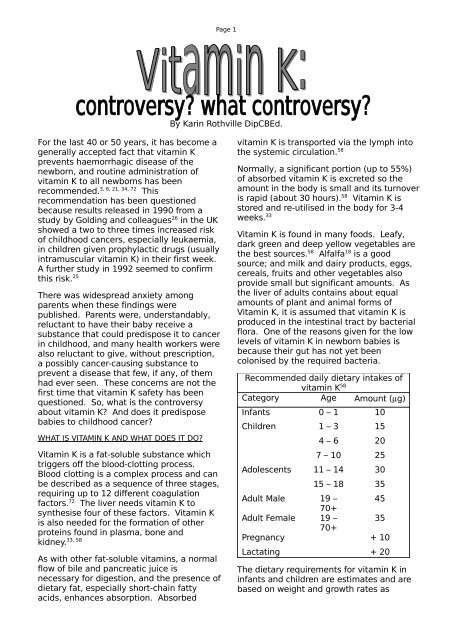

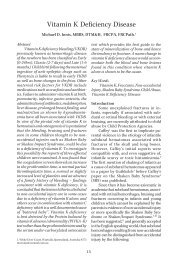
![Murder Inc. [polio/murder.pdf]](https://img.yumpu.com/36142565/1/163x260/murder-inc-polio-murderpdf.jpg?quality=85)
